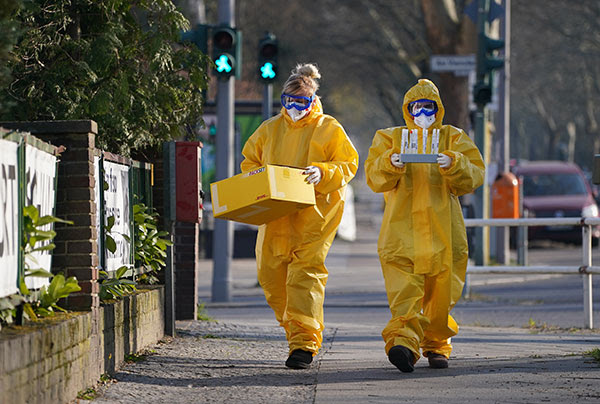
Medical volunteers return to a medical practice after taking blood and throat-mucus samples from visitors to test them for COVID-19 infection at a tent set up next door on 27 March in Berlin, Germany. (Sean Gallup/Getty)
Why Germany’s death rate is so low
- Germany has the fourth-highest number of confirmed coronavirus infections — more than 100,000. But its death rate is an order of magnitude lower than those in nearby Italy and Spain. One reason is a quirk of fate: many of the first to be infected were young, healthy people who caught the virus in Austrian and Italian ski resorts. Germany has also tested many people with few or no symptoms, lowering the death rate on paper. And the country has a robust free public-health system with lots of intensive-care beds, a trusted government whose social-distancing guidelines are widely observed and an aggressive approach to early testing and treatment. (The New York Times | 10 min read)
- The genome of SARS-CoV-2 is less than 30,000 letters long — short enough that The New York Times can spell it out in this infographic-packed feature. Take a journey through the virus’s full genome, the proteins it encodes, what they do and a few mysteries. (The New York Times | 7 min read)
- Staying at home is not an option for scientists working on potential vaccines or caring for research animals. Four scientists offer advice on the precautionary measures necessary to continue essential research in the face of the pandemic. (Nature | 9 min read)
- The Copenhagen polio epidemic of August 1952 was the outbreak that invented intensive care — the approach so important in fighting COVID-19. It was one of the worst polio epidemics that the world had ever seen, and half the victims were children. A heroic community effort brought to life the idea of anaesthesiologist Bjørn Ibsen: that a new type of ventilator could breathe for a person for hours or days. (Nature | 7 min read)
- A tiger at a zoo in New York City is the first known wild animal to test positive for the virus that causes COVID-19. Veterinarians guess that the big cat probably caught the coronavirus from a zookeeper. The finding adds to concerns that vulnerable wild animals, including great apes, could be at risk from the illness. (National Geographic | 6 min read)





















.png)












No hay comentarios:
Publicar un comentario